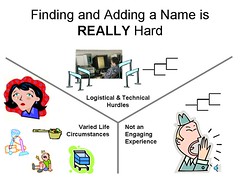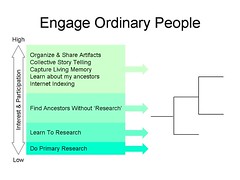Why Take Genealogy to the Common Person?
Imagine a world where average people have a strong understanding of their heritage; the legacy and values of their ancestors; and interactions with others are in the context of their relationships – this guy sitting across the table from me is my 3rd cousin. Understanding our heritage and relationships brings more meaning and stability to life.
Interestingly, a high percentage of adults (estimates vary from 65-85%) have a desire to know more about their ancestors. There seems to be an innate desire to understand our heritage yet most people that go down this path are quickly overwhelmed by the obstacles. The end result is that while the majority of adults in the world are interested in the domain of family history at some level, very few are able to contribute productively to the effort of mapping the family of man. How might the world be different if the efforts of all the people interested in their roots could be harnessed and channeled to contribute more meaningfully toward the overall challenge of mapping our common family tree?
Finding and Adding an Ancestor to a Pedigree is REALLY Hard

The reality of the world today is that for ordinary people finding and adding a name to their pedigree is very difficult. The challenges inherent to finding a name can be categorized into three areas: logistic and technical hurdles, varied life circumstances, and the reality that today’s tools don’t offer an engaging experience. These problem areas will be described in more detail in future posts. Solving these problems is a matter of answering the following questions:
- How do we remove logistic, technology, knowledge, skill, & economic barriers?
- How do we let ordinary people in a broad range of life circumstances contribute meaningfully?
- How do we deliver an experience that is inviting, interesting, and fulfilling?
Engaging Ordinary People

The diagram above represents a conceptual model for how to harness the efforts of ordinary people. It involves offering a broad range of activities that are inter-related. Each activity is meaningful in and of itself while contributing to the overall effort of a common family tree. Activities toward the top of the list are likely to have broader participation than those at the bottom of the list. As long as an activity adds to the overall effort of building our common heritage, it belongs on the list. The Web 2.0 philosophies and related technologies play very nicely into such a model.
Please offer your feedback on the ‘Engagement Model’ by adding comments to this post. Do you think this model has the potential to harness the combined efforts of millions?

1 comment:
I just received an e-mail from a well-known and respected genealogist. They offer some great feedback on the topic of engaging ordinary people.
There are a couple of things this person points out through e-mail that are significant.
1. Primary research should not be positioned as a turn off. With a little education it can be very engaging.
2. "The items at the top of the scale [sharing artifacts, storytelling, etc.] have a role to play in getting people to embrace learning and then enjoy research."
The chart is intended to reflect that the total number of participants at the top is likely to be greater than those that do primary research. As they participate in these activities we can try to broaden their participation in other activities and lead them toward research. Some will never gravitate that was and that is ok. For those that do move toward research, we'll make it as interesting and easy to get there as possible.
Post a Comment